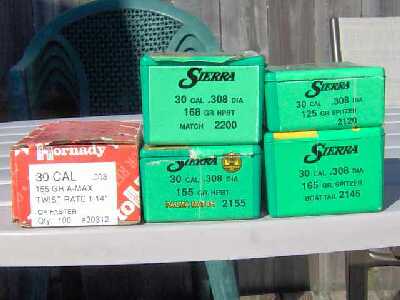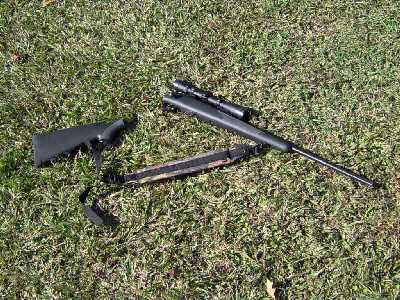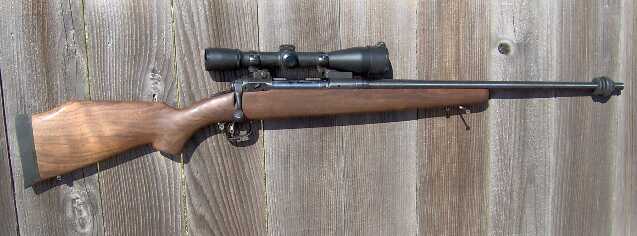Copyright 2009 by Dennis Dezendorf
|
In the sporting world there are some cartridges against which all others can be measured. The .22 Long Rifle cartridge is a well-known benchmark, as is the .38 Special, the 30-30 Winchester, and the .44 Magnum. Each of these cartridges are immediately known to the American shooter. You can find them at almost any sporting goods shop and most people are familiar with their performance.
In rifle cartridges, one stands above all the others as a benchmark for performance. It was originally designed as a military cartridge, the .30 caliber of 1906. Some books list it as the 30-06 Springfield. GIs used it in in rifles and machine guns from 1906 to the 1960s. As a sporting cartridge, it's been chambered in bolt rifles, semi-autos, pumps, single shots. It's hard to find a rifle manufacturer who doesn't chamber a rifle in the 30-06. While it's true that some cartridges are more powerful, faster, flatter shooting, it's also true that at one time or another they've been compared to the 30-06 as a known basis of performance. The 30-06 is a premier benchmark caliber. In early 2006 I realized that I didn't own a 30-06, and that seemed a travesty. Commercial 30-06 rifles are easy to find and I started looking for one to add to my battery. Frugal Outdoorsman readers know I am a fan of Savage rifles. They are sturdy, plain, work guns. The fact that they are accurate right out of the box is compelling, but they have other benefits, not the least of which is their popular pricing. So, in February 2006, I was driving past a local sporting goods store and the sign out front advertised a rifle sale. I stopped in and saw a Savage Model 110, in 30-06 on the shelf. I put it on layaway. That rifle had the Accutrigger, a design first released in the spring of 2002 on the Savage law enforcement rifles. The Accutrigger uses the center lever to positively block the sear. As your trigger finger moves the center lever, the sear block moves away from the sear and the trigger is free to fire. Savage was able to manufacture a good trigger that is safe to use. There is no danger of accidental discharge with the Accutrigger. In 2005 I had purchased a Weaver K6 scope, almost as an impulse buy. I've owned variable scopes, but I've never liked them. I seldom use the variable option. I usually set the scope on about 4 or 6 power and leave it alone. One day in 2005 I had noticed that Midway had the Weaver K6 on sale, so I clicked on it. The Weaver K4 and K6 scopes are fixed power scopes that have a long-earned reputation for durability and simplicity. The six power of the K6 makes it a good scope for a pipeline hunting rifle. It has no bells nor whistles, it just works. When it came in, it lay on my bench unopened for over a year. When I put the new Savage on layaway, I knew that I didn't need a scope, because the K6 was destined to sit on that rifle. In August, I got the rifle off layaway. It was a naked rifle, no sights, neither iron nor glass. I immediately ordered dies and bullets from Midway USA and got out the Brownell's catalog for scope rings and bases. Redfield extended rings solved the problem of getting the little scope far enough to the rear for proper eye relief.
IMR 4895 is a standard powder for the 30-06. 4895 was designed for the cartridge and was loaded in GI ammunition. I happen to like 4895 and keep it on my shelf. Hodgdon makes a 4895, but lists it as a different burning rate. They are not the same powder. They are made in different factories and while they share a common number, they're different. Hodgdon bought the rights to IMR powder a few years ago and they market both powders. There are several good powders for the 30-06, including both IMR and Hodgdon 4350, IMR and Hodgdon 4895, Alliant Reloder 19 and Reloder 22, just to name a few. Prudent handloaders might use any of these powders with good results. Follow safe handloading procedures, follow published recipes, and you'll be fine. Of course, every major ammunition manufacturer makes 30-06 ammunition and it is available everywhere ammo is sold. With the ammo crunch of the winter of 2008, lots of ammo flew off dealer shelves. Today, supplies are stabilizing and 30-06 ammo is available again. But, back to my rifle. It was a plain-jane Savage with the plastic (tupperware) stock. Durable, steady, inexpensive. I'm not going to bore you with tables or graphs and charts. This was a hunting rifle and it acted like a hunting rifle. It shot everything relatively well, 150 grain bullets, 168 grain bullets, IMR powder, Alliant powder, it didn't matter. It shot everything into just over an inch at 100 yards. I spent over $100.00 on bullets and probably that much on powder and found nothing that really shined. Sure, some groups were tantalizingly small, a couple of them fell under an inch, but I'm not a benchrest shooter and this was not a benchrest rifle. It was a hunting arm, plainly and simply.
Nothing left to do that season, but retire the rifle for the time being and hunt with other arms. Come the spring of 2008 I ordered a "Finished" Wood Plus walnut stock from Brownell's, along with a steel trigger guard. They arrived in the mail within days and I began the process of installing the stock and adding sling studs, floating the barrel, and bedding the action. I took the nearly completed rifle to my gunsmith, who added a Limbsaver recoil pad. By early summer I was ready to start the process of working up loads again. When you change a rifle you change the way it recoils and the harmonics of the barrel. With a new stock, everything changes. But, to my surprise, the rifle liked the same ammo and shot it to very nearly the same point of impact. Let's talk for a minute about fitting a stock. Some folks think when we order a stock, it should fit the rifle perfectly. That isn't normally the case. Stocks often require some hand-fitting, which takes some time. The work isn't especially difficult, and only requires a rat-tailed file, some sandpaper, a piece of dowel, and patience. It's a file and fit operation that takes time. Go slowly, concentrating on one part of the rifle at a time. The stock might be tight around the trigger group. Take off a little wood and try it again. Fitting the stock to this rifle took me about three hours of sand and fit. It's a job that's easily in the range of the garage handyman, but don't get in a hurry. The extra minutes you spend getting it right will pay dividends later. The folks at Midway USA have a number of videos online to help with your home gunsmithing tasks. In the one linked here, Larry Potterfield talks about floating a rifle barrel. Where Larry uses a barrel channel scraper, I use a piece of sandpaper wrapped around a dowel. My method works just as well as his and doesn't require any special tools. I was able to use the same sling studs that came from the broken stock, so the cost for those was zero. Another good video from Midway is the one about bedding a rifle. Instead of using the supplies that Larry sells, many of us use commercially available compounds. Some bed rifles with JB Weld. Others use common epoxy. For release agent, I use common axle grease I buy at the local auto parts store. The videos are a great asset to the do-it-yourself gunsmith. If you're able to read this article online, then there is a wealth of gunsmithing information available over the internet. Use it and don't be afraid to try some of these projects at home. Get the information, go slowly, and have fun. As you see below, it's a good looking rifle. It weighs in at 8 lbs, which is a good weight for a hunting rifle. The extra pound of the walnut stock helps to soak up recoil. It still shoots a variety of ammo to just over an inch at 100 yards. With a more powerful scope and better benchrest technique, I'm sure I could improve on that, but this is a hunting rifle. I'm really pleased with the way the rifle handles and shoots in this stock. It's right at home in a hunting camp, which is what I intended when I began the project.
If you look at the photo, you'll see a gizmo on the end of the barrel. That's a De-Resonator, made by the Limbsaver folks. It's a big soft rubber grommet that is supposed to soak up the vibrations in the barrel and give better accuracy. They cost about $20.00 everywhere. I decided to try it and bought one locally. The instructions that come with the device say to slip it on the barrel and move it back and forth until you find the "sweet spot" where the vibrations are dampened and the group size magically shrinks. The instructions also say that for a supported barrel, start about 4" from the forearm and for a floated barrel, start about 4" from the muzzle. I took some hunting loads to the range and started playing with the device. Groups seemed to shrink a little, but again, this is a hunting rifle and I don't have much of a benchrest technique. Where the De-Resonator shines is as a barrel protector. I have a bad habit of leaning my rifle on any convenient surface and with the rubber device on the end of the tube, if I prop my rifle in a corner, or against a wall, or pickup truck, it sticks. I haven't dropped the rifle since I intstalled the De-Resonator, and I've given it pleny of opportunity to fall over. Junior says he wouldn't put one on his rifles for green American money. But that's Junior. He's not as tough on his rifles as I am. I like the 30-06 cartridge. It's a very common chambering, manufactured by most of the sporting arms makers. Just off the top of my head, Marlin, Savage, Remington, Ruger, Sako, CZ, Howa, and H&R all make rifles in that caliber. Ammo is available anywhere ammunition is sold. Reloading components are easy to find and everyone has data for the cartride. You can use bullets fron 110 to 220 grains. The 30-06 has enough power for the average hunter without excessive recoil. Rifles for it are relatively inexpensive, whether bought new or off the used gun racks. Some models are availble new for under $500.00, and if you're looking for a good clean used rifle you can have your pick of the litter for that amount. It's an old cartridge, 103 years as of this writing, but it's a good cartridge. It may not do all the things that the new whiz-bang cartridges do, but they are all measued against it. There is a lot to like in the 30-06. |
 Once the scope was mounted, I began working up loads for the rifle. The 30-06 shines with a number of powders and can use bullets from 110 to 220 grains. Most folks use bullets in the 150 to 170 grain range. I ordered some Hornady A-Max bullets in 150 grain and some Sierra Gameking bullets in 168 grain. I also ordered some Sierra Matchkings in both 155 and 168 grain.
Once the scope was mounted, I began working up loads for the rifle. The 30-06 shines with a number of powders and can use bullets from 110 to 220 grains. Most folks use bullets in the 150 to 170 grain range. I ordered some Hornady A-Max bullets in 150 grain and some Sierra Gameking bullets in 168 grain. I also ordered some Sierra Matchkings in both 155 and 168 grain.
 In 2007, tragedy struck. I was in a tripod stand, about 12 feet off the ground, watching a couple of deer trails crossing a petroleum pipeline. By noon, I hadn't seen anything and decided to go to the camp for lunch. I had a rope on that stand so I could lower the rifle to the ground. I unloaded the rifle, tied it to the rope and lowered it over the side of the stand. The knot turned loose and the rifle fell to the ground, breaking the stock at the wrist. Dammit!
In 2007, tragedy struck. I was in a tripod stand, about 12 feet off the ground, watching a couple of deer trails crossing a petroleum pipeline. By noon, I hadn't seen anything and decided to go to the camp for lunch. I had a rope on that stand so I could lower the rifle to the ground. I unloaded the rifle, tied it to the rope and lowered it over the side of the stand. The knot turned loose and the rifle fell to the ground, breaking the stock at the wrist. Dammit!
